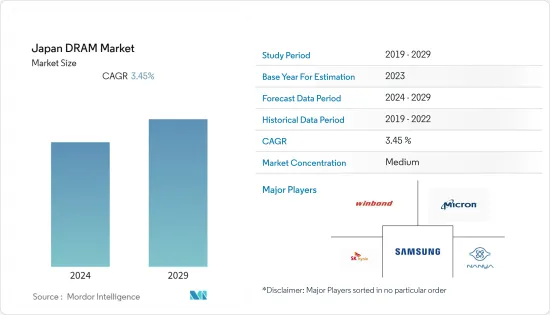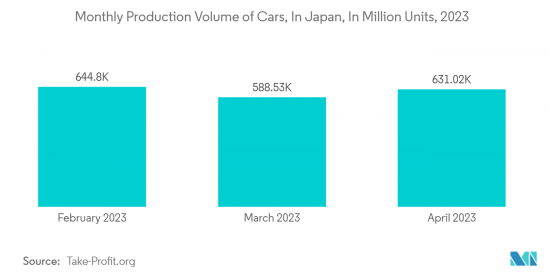 |
市場調查報告書
商品編碼
1408741
日本DRAM:市場佔有率分析、產業趨勢與統計、2024年至2029年成長預測Japan DRAM - Market Share Analysis, Industry Trends & Statistics, Growth Forecasts 2024 - 2029 |
||||||
※ 本網頁內容可能與最新版本有所差異。詳細情況請與我們聯繫。
日本DRAM市場規模為33.5億美元,預計在預測期內將達到39.7億美元,複合年成長率為3.45%。

主要亮點
- 智慧型手機、個人電腦和筆記型電腦在日本越來越普及,並且正在開發 DRAM 以縮短啟動時間並增加記憶體容量以實現高效能。
- 根據日本智慧型手機安全協會(JSSEC)統計,2022年7月國內行動電話出貨為142萬台,2022年5月為68萬台。此外,與前幾代相比,支援 5G 的智慧型手機需要更多記憶體。因此,5G實施的推動將有助於市場成長。
- 相機、平板電腦、感測器、工業設備、醫療設備和汽車系統等消費性產品依靠處理器嵌入的 DRAM 快閃記憶體來儲存資料和可執行程式碼。然而,資料中心使用DRAM閃存,它可以近乎即時地回應讀寫請求,且資料傳輸速度很快。隨著人工智慧和機器學習應用大規模資料處理需求的增加,DRAM 儲存趨勢可能會繼續發展。
- 技術進步、人口成長、人均收入增加以及高速網路的便利性正在推動智慧型手機和先進家用電器在日本的普及。因此,具有高處理能力和增強儲存能力的智慧型手機、平板電腦、筆記型電腦等的產量正在增加,預計將推動日本的動態隨機存取記憶體(DRAM)市場。
- 總體而言,資料中心和汽車產業的崛起預計將推動日本動態隨機存取記憶體(DRAM)市場的龐大需求。預計消費電子產業的需求在預測期內將保持穩定。
- 隨著遊戲、汽車、醫療保健、通訊以及更重要的 5G 和人工智慧 (AI) 等促進因素的記憶體需求不斷增加,各公司正在專注於新型創新 DRAM 產品。 2022年6月,美光科技宣布計畫在其廣島工廠大量生產先進的DRAM記憶體晶片。該公司將在日本生產「1-BETA」記憶體晶片。
- 此外,美光宣布將於 2022 年 11 月在廣島工廠開始量產新型高容量、高功率1-BETA 動態隨機存取記憶體(DRAM)晶片。該公司還從日本政府獲得了 3.2 億美元用於製造先進晶片。
日本DRAM市場趨勢
汽車業佔有較大佔有率
- 電動車、SUV 和輕型商用車需求的不斷成長預計將推動日本動態隨機存取記憶體 (DRAM) 市場的需求。日本政府以本田、豐田、SUZUKI、三菱、日產等各種國產品牌為主。
- 隨著電動車的普及和資訊娛樂系統的快速發展,半導體汽車平台正面臨模式轉移。高畫質地圖、視訊串流和 3D 遊戲等資訊娛樂系統的先進功能,加上 ADAS 需求的激增,將在預測期內推動整個汽車行業對大容量、高性能固態硬碟 (SSD) 的需求…預計將顯著推動圖形DRAM 的需求。
- 在預測期內,汽車產業對日本動態隨機存取記憶體(DRAM)市場的需求很高。推動需求的關鍵因素之一是人們越來越關注包含 5G 基礎設施的自動駕駛技術。例如,特斯拉採用了Nvidia的CPU和GPU解決方案,並推動涵蓋GDDR5 DRAM產品。
- 此外,汽車產業中物聯網 (IoT) 的出現已成為多功能應用的熱點。從聯網汽車到自動交通系統,物聯網在汽車市場中的作用預計將為日本 DRAM 市場帶來巨大商機。
- 多家汽車製造商正在擴大其在日本的生產設施,以滿足不斷成長的需求並擊敗競爭對手。例如,比亞迪於2023年7月宣布進軍日本小客車市場。本公司提供 Atto 3 型號。比亞迪Atto 3計劃於2023年1月發布。第二款車型是比亞迪Dolphin,預計2023年中期上市,第三款車型是新款比亞迪Seal,預計將於2023年下半年上市。
- 另外,根據汽車工業協會公佈的資料,2023會計年度日本汽車產量在2023年2月增加至6,31,022輛。最大值為 9,61,994 單位,最小值為 2,49,772 單位。汽車產量的增加可能會為日本汽車市場帶來對 DRAM 的高需求。

資料中心和伺服器的增加推動了市場
- 動態隨機存取記憶體 DRAM 是現代企業和資料中心應用程式正常運作的重要元件。隨著越來越多的資料中心利用雲端運算、虛擬和軟體定義伺服器技術,斷電和備用發電機啟動之間的時間正在縮短。
- 物聯網IoT技術和巨量資料預計將增加對資料中心的投資,進一步為日本動態隨機存取記憶體(DRAM)市場帶來新的成長機會。日本公司在所有行業都經歷大量資料生成,包括醫療保健、銀行、金融服務和保險 (BFSI)、IT 和通訊以及政府和國防。雲端運算的成長、國外雲端供應商普及的提高以及國內企業投資的增加是推動市場成長的主要因素。
- 新行動運算設備的激增正在提高各種組織中資料中心的效用。此外,許多供應商正在市場上建立新的資料中心,推動了正在研究的市場。例如,Datadog, Inc.於2023年4月宣布將在東京開設一個新的資料中心。新資料中心將透過在本地處理和儲存資料來幫助公司及其客戶遵守本地資料隱私和安全法規。
- 同樣,2023年1月,Optage Co., Ltd.宣布計劃在大阪建造新的資料中心。該物業位於東梅田區,面積2,250平方公尺,共14層。
- 為了滿足這些要求,供應商正在發布新產品以保持市場競爭力。例如,2022年5月,三星電子宣布開發基於Compute Express Link的DRAM記憶體技術,以升級資料中心效能。此DDR5設計用於支援CXL介面。 CXL 介面是基於 PCI Express (PCIe) 5.0 介面的開放式產業標準互連,使資料中心能夠在處理器、主機、記憶體緩衝區、加速器和輸入/輸出等設備之間提供高速、低延遲的通訊設備。它的設計目的是。
- 此外,政府主導的舉措在日本變得更加活躍,日本對動態隨機存取記憶體 (DRAM) 的需求也以類似的速度成長。例如,2022年8月,日本政府宣布計分類散和多樣化海底電纜登陸點,並在全國範圍內建造多個新的資料中心。政府的目標是縮小都市區差距,提高抵禦自然災害和潛在破壞的能力。
日本DRAM產業概況
日本動態隨機存取記憶體(DRAM)市場的特點是整合緩慢,眾多主要企業爭奪市場佔有率。三星電子、SK 海力士和華邦電子等知名企業在塑造該行業方面發揮關鍵作用。我們致力於持續創新,並以大量研發投資為後盾,幫助我們獲得相對於同業的競爭優勢。
2023 年 1 月,SK 海力士推出了 LPDDR5TDRAM,比現有 LPDDR5X 技術取得了重大進展。這種創新的LPDDR5T技術適用於人工智慧、智慧型手機、虛擬實境、增強智慧和機器學習等多種應用。
2022 年 12 月,三星電子宣布推出 16 Gigabit DDR5 DRAM。這種尖端 DRAM 採用業界首創的 12 奈米級製程技術製造,特別適合提高資料中心、下一代運算和人工智慧驅動系統等營運的永續性。
2022年5月,知名記憶體和數位儲存產品製造商創見資訊(Transcend)宣布推出專為商用和個人電腦設計的新一代DDR5 DRAM模組。 Transcend 的 DDR5 記憶體模組在速度、容量和可靠性方面超過了 JEDEC 標準,為元宇宙、高效能運算 (HPC) 和虛擬經濟等應用提供了突破性的效能。
其他福利:
- Excel 格式的市場預測 (ME) 表
- 3 個月的分析師支持
目錄
第1章簡介
- 研究假設和市場定義
- 調查範圍
第2章調查方法
第3章執行摘要
第4章市場洞察
- 市場概況
- 產業價值鏈分析
- 產業吸引力-波特五力分析
- 供應商的議價能力
- 消費者議價能力
- 新進入者的威脅
- 替代品的威脅
- 競爭公司之間敵對關係的強度
- 宏觀經濟走勢對市場的影響
第5章市場動態
- 市場促進因素
- 高階智慧型手機和消費性電子產品的普及
- 市場挑戰
- 原物料和生產價格上漲
第6章市場區隔
- 依架構
- DDR3
- DDR4
- DDR5
- DDR2/其他架構
- 按申請
- 智慧型手機/平板電腦
- 個人電腦/筆記型電腦
- 資料中心
- 圖形
- 消費性產品
- 車
- 其他應用
第7章 競爭形勢
- 公司簡介
- Samsung Electronics Co. Ltd.
- Micron Technology Inc.
- SK Hynix
- Nanya Technology Corporation
- Winbond Electronics Corporation
- Transcend Information
- Kingston Technology
- Infineon Technologies AG
- ATP Electronics
- Elpida Memory Inc.
第8章投資分析
第9章市場的未來

The Japan dynamic random access memory (DRAM) market was valued at USD 3.35 billion in the current year and is expected to register a CAGR of 3.45%, reaching USD 3.97 billion over the forecast period.
Key Highlights
- The growing adoption of smartphones, PCs, and laptops in the country has increased the development of DRAM, which could reduce the boot-up time and enhance the memory space to offer higher performance.
- According to the Japan Smartphone Security Association (JSSEC), the monthly domestic shipment volume of mobile phones in the country was 1.42 million units in July 2022, which was 0.68 million units in May 2022. Further, 5G-enabled smartphones need more memory compared to previous generations. Thus, the increasing implementation of 5G contributes to market growth.
- Consumer products, such as cameras and tablets, sensors and industrial equipment, medical devices, and automotive systems, rely on DRAM flash memory embedded alongside processors to store data and the code they execute. However, data centers use DRAM flash memory for its near real-time response to read/write requests and high data transfer speed. DRAM storage trends are likely to continue to evolve as demand increases for large-scale data processing for artificial intelligence and machine learning applications.
- The advances in technology, increasing population, rise in per capita income, and easy availability of high-speed internet have increased the adoption of smartphones and advanced consumer electronics in the country. Therefore, the growing production of smartphones, tablets, laptops, and others with high processing and enhanced memory capabilities is expected to propel the Japanese dynamic random access memory (DRAM) market.
- Overall, the rising data centers and automotive sectors are expected to create massive demand for the Japanese dynamic random access memory (DRAM) market. The demand from the consumer electronics sector is expected to be constant during the forecast.
- With the increased memory requirements in gaming, automotive, healthcare, telecommunication, and, more importantly, with growth drivers like 5G and artificial intelligence (AI), the companies have been focusing on new and innovative DRAM products. In June 2022, Micron Technology announced its plan to mass-produce advanced DRAM memory chips at its Hiroshima plant. The company would be manufacturing its '1-Beta' Memory Chips in Japan.
- Moreover, in November 2022, Micron announced to start of mass production of its new high-capacity, power 1-beta dynamic random access memory (DRAM) chips at its plant in Hiroshima, Japan. The company has also received USD 320 million from the Japanese government to make advanced chips.
Japan DRAM Market Trends
Automotive Sector Holds Significant Market Share
- The country's growing demand for electric vehicles, SUVs, and light commercial vehicles will boost the demand for Japan's dynamic random access memory (DRAM) market. The government is dominated by various domestic brands such as Honda, Toyota, Suzuki, Mitsubishi, and Nissan.
- The proliferation of electric vehicles and the rapid advancement of infotainment systems are causing the semiconductor automotive platform to face a paradigm shift. Advanced features in infotainment systems like high-definition maps, video streaming, and 3D gaming, coupled with soaring demand for ADAS, are expected to significantly drive the demand for high-capacity, high-performance solid-state drivers (SSDs), and graphics DRAM throughout the automotive industry during the forecast period.
- The Japan dynamic random access memory (DRAM) market has witnessed high demand from the automotive industry during the forecast period. One of the major factors driving the demand is the growing emphasis on autonomous driving technologies with built-in 5G infrastructure. For example, Tesla has adopted Nvidia's CPU and GPU solutions, which drove them to incorporate GDDR5 DRAM products.
- Furthermore, the advent of the Internet of Things (IoT) in the automotive industry has become a prominent hotspot for multi-purpose applications. From connected vehicles to automated transport systems, the role of IoT is expected to open up significant opportunities for the Japan DRAM market in the automotive market.
- Several automobile manufacturers are expanding their production facilities in Japan to meet the growing demand and stay ahead of the competition. For instance, in July 2023, BYD announced it to expand its footprint in Japan's passenger vehicle market. The company will offer the Atto 3 model. BYD Atto 3 is expected to go on sale in January 2023. The second model is the BYD Dolphin, scheduled to be released in mid-2023, and the third model is the all-new BYD Seal, expected to be released in late 2023.
- Moreover, according to data published by the Automobile Manufacturers Association, in FY 2023, in Japan, car Production increased to 6,31,022 Units in February 2023. The maximum volume was 9,61,994 Units, and the minimum was 2,49,772 Units. Such a rise in automobiles is likely to bring the high demand for DRAM in the Japanese automobile market.

Growing Number of Data Centers and Servers Will Boost the Market
- Dynamic random access memory DRAM is an essential component for the proper functioning of modern enterprise and data center applications; the growing data centers in Japan have significantly fueled the demand for the market. An increasing number of data centers utilize cloud computing, virtualization, and software-defined server technology, so the time between power failure and startup of the backup generator has shortened.
- The Internet of Things IoT technology and big data will increase investment in the data center, further creating new growth opportunities for Japan's dynamic random access memory (DRAM) Market. Japanese companies are experiencing massive data generation across all industries, including healthcare, banking, financial services, and insurance (BFSI), IT and telecom, and government & defense. The growth of cloud computing, increased penetration by foreign cloud providers, and increased investments by domestic players are some of the major factors driving the market growth.
- The increase in new mobile computing devices has led to the rise in the utility of data centers among various organizations. Further, many vendors in the market are establishing new data centers, driving the studied market. For instance, In April 2023, Datadog, Inc. announced to launch of its new data center in Tokyo, Japan. This new data center in Japan will help the company and its customers comply with local data privacy and security regulations by processing and storing data locally.
- Similarly, in January 2023, Optage Inc. announced plans to construct a new data center in Osaka, Japan. The facility is located in the Higashi-Umeda district, covers an area of 2,250 square meters, and has 14 floors.
- In order to cater to such requirements, vendors are releasing new products to remain competitive in the market. For instance, in May 2022, Samsung Electronics announced the development of DRAM memory technology based on the Compute Express Link to upgrade the performance of the data centers. The DDR5 is designed to support the CXL interface, which is an open industry-standard interconnect based on the PCI Express (PCIe) 5.0 interface that is designed to enable the data centers with high-speed and low latency communications between the processor, host, and the devices such as memory buffers, accelerators, input and output devices.
- Moreover, with the growing government initiative in the country, the demand for Japanese dynamic random access memory (DRAM) has also been increasing at a similar rate. For instance, in August 2022, the Japanese Government announced plans to build several new data centers across the country along with decentralizing landing bases for submarine cables to diversify landing points. Through this, the Government aims to reduce the disparity between rural and urban areas and provide greater resilience against natural disasters or potential sabotage.
Japan DRAM Industry Overview
The dynamic random access memory (DRAM) market in Japan is characterized by moderate consolidation, with numerous key players vying for an increased market share. Prominent companies such as Samsung Electronics, SK Hynix, and Winbond, among others, play a pivotal role in shaping the industry. Their commitment to incessant innovation, underpinned by substantial investments in research and development, has facilitated their attainment of a competitive edge over their peers.
In January 2023, SK Hynix unveiled its LPDDR5TDRAM, representing a noteworthy advancement over the existing LPDDR5X technology. This innovative LPDDR5T technology is well-suited for diverse applications, including artificial intelligence, smartphones, virtual and augmented reality, and machine learning.
In December 2022, Samsung Electronics Co., Ltd. introduced its 16-gigabit (Gb) DDR5 DRAM. This cutting-edge DRAM is crafted utilizing the industry's first 12nm class process technology, making it highly suitable for enhancing sustainability in operations, especially in data centers, next-generation computing, and AI-driven systems.
In May 2022, Transcend Information, Inc. (Transcend), a renowned manufacturer of memory and digital storage products, announced the availability of its next-generation DDR5 DRAM modules, specifically designed for both business and personal computers. These DDR5 memory modules from Transcend surpass JEDEC standards in terms of speed, capacity, and reliability, ushering in groundbreaking performance in applications such as the metaverse, high-performance computing (HPC), and the virtual economy.
Additional Benefits:
- The market estimate (ME) sheet in Excel format
- 3 months of analyst support
TABLE OF CONTENTS
1 INTRODUCTION
- 1.1 Study Assumptions and Market Definition
- 1.2 Scope of the Study
2 RESEARCH METHODOLOGY
3 EXECUTIVE SUMMARY
4 MARKET INSIGHTS
- 4.1 Market Overview
- 4.2 Industry Value Chain Analysis
- 4.3 Industry Attractiveness - Porter's Five Forces Analysis
- 4.3.1 Bargaining Power of Suppliers
- 4.3.2 Bargaining Power of Consumers
- 4.3.3 Threat of New Entrants
- 4.3.4 Threat of Substitute Products
- 4.3.5 Intensity of Competitive Rivalry
- 4.4 Impact of Macroeconomic Trends on the Market
5 MARKET DYNAMICS
- 5.1 Market Drivers
- 5.1.1 Growing Adoption of High-End Smartphones and Consumer Electronics
- 5.2 Market Challenges
- 5.2.1 Rising Raw Material and Production Prices
6 MARKET SEGMENTATION
- 6.1 By Architecture
- 6.1.1 DDR3
- 6.1.2 DDR4
- 6.1.3 DDR5
- 6.1.4 DDR2/Other Architecture
- 6.2 By Application
- 6.2.1 Smartphones/Tablets
- 6.2.2 PC/Laptop
- 6.2.3 Datacenter
- 6.2.4 Graphics
- 6.2.5 Consumer Products
- 6.2.6 Automotive
- 6.2.7 Other Applications
7 COMPETITIVE LANDSCAPE
- 7.1 Company Profiles
- 7.1.1 Samsung Electronics Co. Ltd.
- 7.1.2 Micron Technology Inc.
- 7.1.3 SK Hynix
- 7.1.4 Nanya Technology Corporation
- 7.1.5 Winbond Electronics Corporation
- 7.1.6 Transcend Information
- 7.1.7 Kingston Technology
- 7.1.8 Infineon Technologies AG
- 7.1.9 ATP Electronics
- 7.1.10 Elpida Memory Inc.









